With the hype around Apple’s latest announcements you’d be forgiven for thinking they’re the first company to bring us AR.
Following Apple’s first keynote in its brand new HQ, people predictably started drooling over the iPhone X (at the time of writing, the unveiling video below attracted over 20 million views in just a few days) in spite of the epic fail of the face recognition feature demo.
Apple suffered an epic fail during its face recognition feature demo Share on X
iPhone sales show no sign of slowing down Share on X
Still, the company has sold plenty of iPhones over the years and that growth shows no sign of slowing down, as the infographic below helps to illustrate:
The other headline grabber from the keynote, however, was Apple ARKit. Because let’s face it. When the world’s biggest technology company officially throws their hat onto the ring, you start paying attention. But I have to say that after watching several ARKit demos, my first reaction was rather…. Meh.
Much of the stuff that had pundits raving were interesting but quite basic, on the level with ideas such augmenting your experience of drinking a cocktail with artistic imagery. In other words, it was nice to see Apple joining the party, but as usual the company tends to act like the whole party has been its idea all along, and people tend to buy into that narrative, because, well, they’re Apple.
Personally, I had been much more impressed by the various HoloLens demos and applications I’d seen over the past year or so. Yet to be fair to the Apple enthusiasts out there, the HoloLens is not aimed at the consumer market, and it does have some serious limitations, as Scott Montgomerie, CEO of Scope AR points out:
“Microsoft has created an amazing experience with the HoloLens – they’ve achieved very stable tracking and have a head-worn device with decent optics, which are certainly a couple of the moving parts required for a complete AR solution. It suffers from a few downsides though, such as the field of view being quite small, which is a turn off for many people, and the user experience is foreign; also the price is far too high for most consumers (and even enterprises) to buy. The primary reason for the cost is the bill of materials, which includes a few depth cameras and specialized processing units that are required for the amazing tracking abilities.”
Tracking is in fact key to creating the optimum consumer AR experience. Stable tracking involves keeping track of your device’s precise position and rotation in real space so that the augmentation can be placed on the world appropriately. This is something the HoloLens does very well, providing what it calls “six degrees of freedom” which allow for very natural interaction between the user and holographic information and objects placed around real-world environments.
Retailers like Ikea have developed content for Apple's ARKit Share on XYet having developed products for both the HoloLens and ARKit, Montgomerie believes that what gives Apple an edge is that it has managed to replicate the HoloLens quality of tracking, but with the same hardware found in modern smartphones going back to September 2015, which accounts for about 380 million iPhones in the market today.
“That means that consumer-level AR experiences will be available to a large segment of the population immediately, and removes a major barrier to entry for the adoption of AR. It’s not the utopian AR experience of a light, cheap, head-worn AR experience that everyone is looking for, but it’s certainly a step in the right direction,” he says.
Beck Besecker, CEO and Co-Founder of Augmented Reality company Marxent, believes that Apple’s involvement provides a clear signal that AR is quickly becoming the next computing platform. While retailers like IKEA have already announced plans to use ARKit to build their own AR apps, however, the challenge will be to build truly meaningful content that goes beyond simple gimmicks and limited use of 3D content:
Tim Cook is betting on the potential of Augmented Reality Share on X“Use cases such as shopping in AR and configuring multiple products you may be interested in buying within a scene have to be seamless in order to motivate people to use them, and ARKit alone will be unable to facilitate that. Devs will need to incorporate a CMS for 3D content to work with ARKit, while also working to make 3D content ‘smart,’ to really make the tech ready for retail, and impactful at that. For instance, if I wanted to design a room in AR, I’d want my virtual chair to ‘know’ it should sit on the floor rather than the ceiling. This may seem obvious, but there needs to be some level of AI or structured smart content behind AR apps. Until Apple finds a way to crack that, progress will continue, but perhaps more slowly than many may hope.”
I do agree with Tim Cook in that Augmented Reality (or Mixed Reality as Microsoft calls it) shows even greater potential than VR, certainly for practical, commercial and enterprise applications. And the fact that Apple is pushing it will inevitably draw more pundits and developers, and help accelerate the technology. In spite of having technically been around for many years, the augmented reality industry is still in its infancy according to Montgomerie
“Like anything, all of the various hardware platforms have strengths and weaknesses. There are a lot of moving parts that are going to be required to create the ultimate consumer-level experience that everyone dreams about, and at a price point that will be viable for consumers,” he concludes.
To find out how to leverage VR/AR/MR in your enterprise, Tech Trends offers bespoke Virtual Reality Consultancy support
Alice Bonasio is a VR Consultant and Tech Trends’ Editor in Chief. She also regularly writes for Fast Company, Ars Technica, Quartz, Wired and others. Connect with her on LinkedIn and follow @alicebonasio and @techtrends_tech on Twitter.









